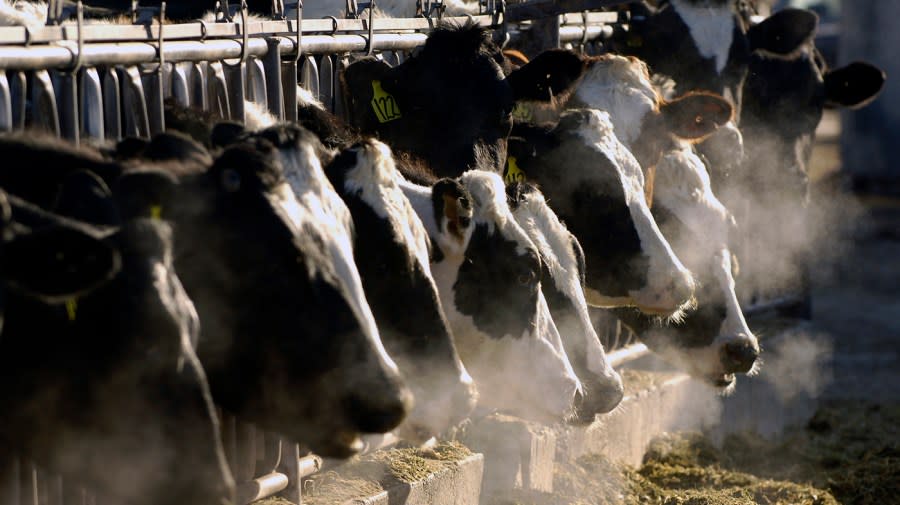Bird flu confirmed in third farmworker: CDC

A second human case of bird flu has been identified in the state of Michigan, the Centers for Disease Control and Prevention (CDC) said Thursday, marking the third farmworker diagnosed with the virus in the U.S. since March.
None of the three cases are associated with the others, the CDC said. As with the previous two cases, the person is a dairy farm worker with exposure to infected cows, but they were working at a different farm than the other case in Michigan.
Unlike with the other two cases, this farmworker had respiratory symptoms including cough without fever, and eye discomfort with watery discharge. In the other cases, the patients’ only sign of illness was pinkeye.
“With the first case in Michigan, eye symptoms occurred after a direct splash of infected milk to the eye. With this case, respiratory symptoms occurred after direct exposure to an infected cow,” Natasha Bagdasarian, Michigan’s chief medical executive, said in a statement.
The patient was given the antiviral Tamiflu and is isolating at home, and their symptoms are resolving. Household contacts of the patient have not developed symptoms, are being monitored for illness and have been offered Tamiflu, the CDC said.
The case does not change the CDC’s bird flu human health risk assessment for the U.S. general public, officials said, because all three cases had direct contact with infected cows.
“The respiratory symptoms we’re seeing in this individual are what we expected. This is after all, a respiratory virus that is known to cause respiratory systems, symptoms that are well known and symptoms that we are on the lookout for,” Nirav Shah, CDC’s principal deputy director told reporters Thursday.
“What the respiratory symptoms tell us more than anything, is that this virus like many viruses can present in more than one way. And for that reason, we should remain alert, not be alarmed,” Shah said.
There’s no evidence yet that the virus is spreading between humans, but Shah noted that a virus in the airway can spread much more easily than an infection in the eye.
Both cases in Michigan were found because officials were actively monitoring farmworkers for symptoms. Still, public health experts have expressed concern that not every state is as vigilant.
Neither farmworker was wearing full personal protective equipment (PPE). Officials stressed that PPE is an important tool in preventing spread among individuals who work on dairy and poultry farms.
“Previously, we focused on the importance of eye protection given the conjunctivitis in the first two cases, but this case also underscores the importance of barrier protection, things like masks and other forms of protection for dairy workers, particularly those who are working with infected cows,” Shah said.
He added that state health departments are distributing PPE, but uptake has been mixed. One of the primary reasons is the difficulty of wearing bulky PPE in hot summer conditions, Shah said.
The CDC said it received a viral sample from the patient on May 29, but didn’t say when the infection occurred.
“Given the extent of the spread of this virus in dairy cows, additional human cases in people with higher risk exposures would not be surprising,” the agency said.
Shah said only about 40 people have been tested, but 350 people are being monitored for potential exposure, including 220 in Michigan.
The CDC said its priority right now is to prevent additional cases of bird flu infections in dairy herd workers, who are at higher risk of exposure.
“CDC has been analyzing data from influenza surveillance systems closely, particularly in affected states, and there has been no sign of unusual influenza activity in people, including in emergency room and laboratory data detection,” the agency said in a statement.
According to the U.S. Department of Agriculture, at least 67 livestock herds in nine states have been infected. In addition to Michigan, dairy cattle herds in Texas, New Mexico, Colorado, Kansas, Idaho, South Dakota, Ohio and North Carolina have tested positive for the H5N1 virus. One of the herds in Idaho was alpacas, the rest were cattle.
Updated at 3:55 p.m.
Copyright 2024 Nexstar Media, Inc. All rights reserved. This material may not be published, broadcast, rewritten, or redistributed.
For the latest news, weather, sports, and streaming video, head to The Hill.


